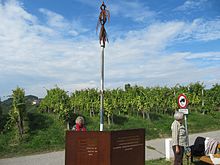Günter Orban
Günter Orban (* 1947 in Vienna ) is an Austrian painter , sculptor , jewelry designer, writer , video and filmmaker .
Life
In 1967 Orban founded the underground film collective group rosa-green-blau , which made a contribution to the new film culture in Austria with experimental films, multimedia shows and film-theoretical manifestos. In 1970 he began painting, sculpting , manufacturing unique jewelry and restoring stone figures on Gothic church facades in Bavaria .
This was followed by founding galleries in Gamlitz Castle, Säusenstein Abbey , in Sernau / Gamlitz and on the Thai island of Kho Pangan.
In Säusenstein Abbey ( Lower Austria ) he created the contemporary interior with the tiled stove cladding, stucco reliefs , fountain sculptures, grand staircases, faience tile floors and the modern stucco facade together with the sculptor and painter Ricca Bach . With Senur Banaike, a Sri Lankan batik artist, designed Günter Orban a large series of paintings on the subject of Theravada - Buddhism .
Together with Ricca Bach, shadow plays, slide and film shows, as well as so-called dual works, are sculptures that both artists worked on at the same time.
In 1996 he produced two art videos for the Styrian state government: "memory space", a film installation for the state exhibition on youth culture and "Create a peace spirit" together with Rotraud Perner for the "Nonviolent Styria" campaign.
In India he taught contemporary painting from 1998 to 2001 at the Tibetan "Norbulingka institute" in Dahramshala and began with the "Rollo pictures", a synthesis of representational and abstract painting. During this time he organized artist symposia and exhibitions in New Delhi in collaboration with the Austrian Ambassador Herbert Traxl.
In 2000 he traveled to Kyrgyzstan with an Austrian delegation of artists to take part in an art symposium with creative people living there. A collective exhibition in the Museum of Fine Art motivated him to donate the pictures he created there to the museum. In honor of the Kyrgyz art critic, academy professor and supporter of Kyrgyz culture Tamara Kasabayev, he founded the "Orbanstiftung", a traveling ring made of gold, amethyst and aquamarine.
In 2004 Günter Orban designed the permanent installation "Taferklasslerstelen" together with 200 pupils from the Darwingasse elementary school in Vienna.
In 2007 he took part in another artist delegation and a cross-national symposium in Tajikistan, at the end of which the paintings and sculptures made there were exhibited and a conceptual installation in the National Museum in Dushanbe took place.
During a work stay in South India in 2008, he began the novel The Green Dagoba - A Spiritual Adventure. which he will finish in 2010.
The infinity pictures, which are 950 unique acrylic on cardboard, were created in 2009.
During a work stay in Sri Lanka in 2010, Günter Orban researched the novel "DIE GRÜNE DAGOBA" and created the picture cycle "Bambus". Together with Helga Michelfeit, he designs illustrations for a Syrian cookbook.
In 1989 Günter Orban received the Leibnitz City Art Prize for sculpture. His works are represented in collections of the Lower Austrian provincial government, the Styrian provincial government, in the Federal Ministry Archives, the Catholic Church as well as in financial institutions and private collections.
Exhibitions
Approx. 200 national and international exhibitions, including in
- 2000 Kyrgyzstan, Museum of Fine Art
- 2001 in the Austrian Parliament ("Lyrikpaintings")
- 2007 Tajikistan, Dushanbe National Museum
Web links
- Personal homepage of the artist
- Web albums with photos of the works ( Memento from May 10, 2016 in the Internet Archive )
- Information page about the Orban Museum
| personal data | |
|---|---|
| SURNAME | Orban, Günter |
| BRIEF DESCRIPTION | Austrian painter |
| DATE OF BIRTH | 1947 |
| PLACE OF BIRTH | Vienna |

